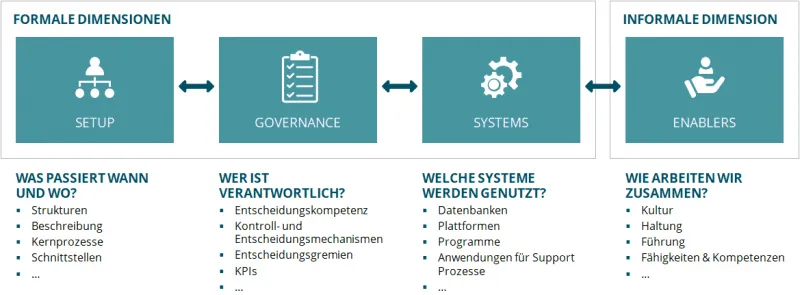
Working or Not - Validation of Organisational Design
Wie wird Organisationsdesigns schon vor der Implementierung auf den Prüfstand gestellt?
Companies are constantly taking a critical look at their organisation: Does it meet the requirements resulting from changing conditions? Can it respond quickly and individually to customer needs? Smaller or larger reorganisations often follow.
In countless coordination loops, guidelines for the new structures, changed processes and responsibilities are defined. However, only a certain part of the future design can be pre-formulated in this planning phase; the much larger part is developed directly during the implementation phase. Nevertheless, the central pillars of the design should be critically scrutinised and validated before the start of implementation.

Wir verstehen Organisationen als Zusammenspiel formaler und informaler Dimensionen. Diese Dimensionen werden bei der Validierung des Organisationsdesigns einzeln aber auch als Gesamtheit betrachtet. Zwar ist jede Reorganisation ein Einzelfall, typischerweise treten jedoch organisationsübergreifend immer wieder ähnliche Herausforderungen auf.
Setup
Interaction at interfaces
The first step in the planning process is to sketch out the organisational structure: Which tasks are grouped together in organisational units? The challenge here lies less in the design of the units themselves than in the meaningful delineation of tasks and in defining the interfaces between the units.
In our experience, structures, roles and tasks within the individual units are always planned in detail, but their integration and interaction with other units are often neglected. As a result, silos are already created during the planning process. For this reason, interfaces should be identified and then tested by means of use case testing based on typical business transactions together with the respective areas. Discussing specific situations makes it possible to understand the collaboration, recognise the need for change and derive appropriate measures for adaptation.
Governance
Gemeinsames Verständnis von Entscheidungsprozessen
Wenn es um Governance geht, muss zunächst Klarheit über die relevanten Entscheidungsprozesse geschaffen werden. Dabei helfen Tools wie z. B. RACI-Matrizen, in denen die jeweilige Zuständigkeit und Verantwortlichkeit detailliert festgelegt ist. Häufig treffen wir Situationen an, bei denen eindeutige Formulierungen – wissentlich oder unwissentlich – unterschiedlich ausgelegt werden. Um solche Situationen zu vermeiden, muss in gemeinsamen Diskussionen sichergestellt sein, dass alle Verantwortlichen der Bereiche ein einheitliches Verständnis über die Grundsätze der Steuerungs- und Entscheidungsprozesse haben. Auch wenn diese Diskussionen sich gelegentlich beschwerlich und langwierig anfühlen, sind sie die Mühe wert. Dabei sollte es nicht nur bei RACIs bleiben, sondern es sollte auch ein Gefühl für sonstige Abstimmungslogiken entwickelt werden. Wenn ein gemeinsames Verständnis herrscht, kann auch in schwierigen Situationen schnell und entschieden gehandelt werden.
Systems
Gradual development of new solutions
Existing platforms and databases should be used in the best possible way and integrated into the new organisational structure. It is not advisable to introduce everything from scratch and throw existing systems overboard. This is because the time and resources required to set up new systems are typically massively underestimated, just as the associated productivity gains are overestimated. You should therefore always first check how existing systems can also be used in the new structures and where other systems are absolutely necessary. During the validation phase, dependencies between areas should always be checked so that the corresponding effects are known in advance and can be responded to during implementation. If new platforms and databases are then actually introduced, there should be precise coordination and a gradual introduction when implementing the reorganisation so as not to overburden employees and managers.
Enablers
Consideration of informal organisational elements
Organisations are ultimately human constructs: Their success depends largely on their employees and their cooperation. This is why the formal elements (setup, governance, systems) must interact with informal elements such as mindset, culture and skills in order to successfully implement a new organisational structure. When defining a new organisational design, careful consideration should therefore be given to which mindsets and skills are required for collaboration in the new organisation. The subsequent comparison between requirements and the current situation in the validation phase shows whether the necessary prerequisites have already been created. Identified gaps can then be closed with training, coaching and other enablement formats. However, as these issues take time, a flexible approach should be used that is continuously developed during implementation. The validation of organisational designs can identify inconsistencies in structures and processes in advance and raise awareness of the sticking points during implementation. However, as changes need to be tested in practice and adapted based on feedback from the organisation, validation is no substitute for a step-by-step and learning approach to implementation. Finally, validation also ensures that employees' confidence in the new organisation is not weakened by avoidable course corrections. This creates the basis for a sustainably successful reorganisation.





